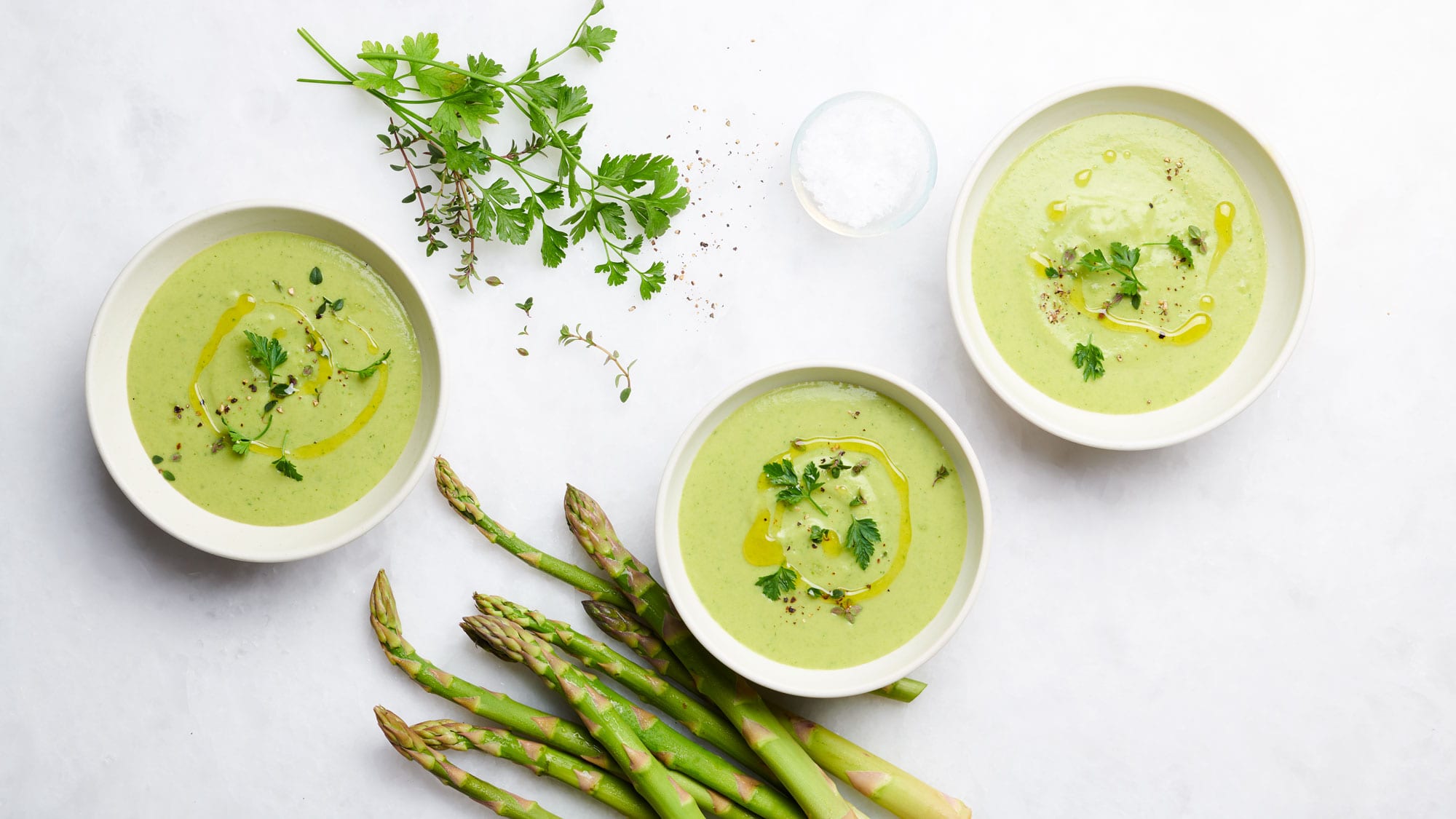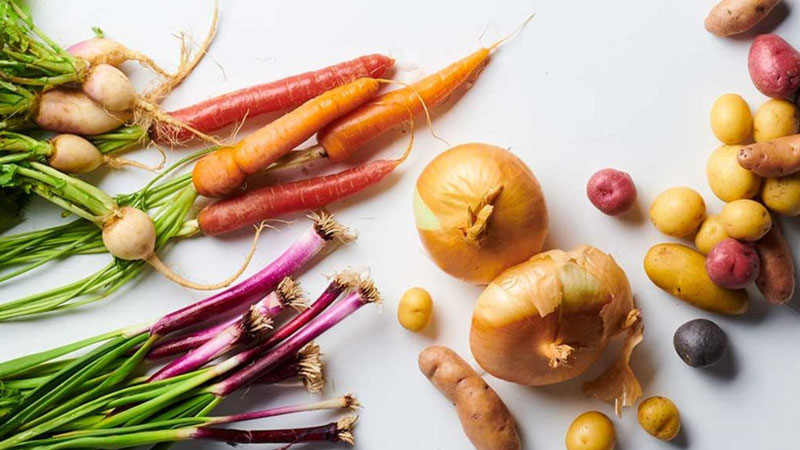Design your own vegetable soup to bring spring closer
By Kim O’Donnel, guest contributor
This article was originally published in March 2024

Many people think of soup as cold-weather food, but it’s a spring-forward way to welcome a new season.
Soup is especially satisfying here because spring can be such a tease in the Northwest. Mother Nature gifts us with that one glorious Vitamin D-rich day – you know the one – that signals change is on the way. Then poof, she changes her mind.
The waiting really is the hardest part, especially if, like me, you’re dreaming of local strawberries. I’ve learned to pass the time and build a bridge between seasons with a pot of blended soup.
A vegetable puree is a gateway to early spring produce, but enriched with the roots and tubers from the winter. Boiled potatoes, sweet potatoes and turnips act as “cream” for quick-cooking green veg like asparagus and spinach. While we wait, the green is a promise of what’s to come. The puree is also more forgiving and versatile than a brothy soup.
Recipe followers, we’ve got you covered with an official “Spring Forward Vegetable Soup” recipe below. But if you’re up for a little kitchen improv, a vegetable puree is a perfect medium for experiments. We’ve designed a template (also below) with all the elements; now it’s your turn to do some designing of your own.
Kim O’Donnel is a chef, journalist and cooking teacher who has written three cookbooks. Find her online at kimodonnel.com.
SPRING FORWARD SOUP
Recipe ©Kim O’Donnel
Makes 6 servings
Kitchen notes: Silt likes to linger in leeks, so make sure to look under the exterior layer, where it tends to congregate. Feel free to swap out spinach for chard and/or tatsoi.
1 to 2 medium potatoes (such as Yukon Gold or Yellow Finn), peeled and quartered)
2 cloves garlic, peeled and left whole
½ to 1½ teaspoons salt
3 tablespoons olive oil
1½ cups chopped leeks (from ½ pound, white and light green parts only, and thoroughly washed)
½ pound fennel bulb, fronds and root removed, cut into ½-inch-thick slices
½ pound asparagus, woody ends removed, cut into 2-inch pieces
3 to 5 sprigs fresh thyme
1 Parmigiano-Reggiano rind (optional but nice)
7 cups spinach washed thoroughly, stemmed and cut into 2-inch pieces (or a frozen ten-ounce bag)
Ground black pepper
Zest of 1 lemon, minced, plus juice of ½ lemon
Place the potatoes, garlic, ½ teaspoon of the salt and 2 cups of water in a medium pot. Bring to a boil. Cover, lower the heat to medium-low and cook until potatoes are fork tender, about 19 minutes.
While potatoes cook, warm the oil in a large, heavy-bottomed pot over medium-high heat. Add the leeks and fennel, stirring until coated with the oil. Cook until softened, about 7 minutes. It’s okay if the leeks get slightly golden in the process.
Add the asparagus, turning until coated. Add the thyme, cheese rind (if using) and enough water to hover at the same level as the vegetables, about 4 cups. Bring to a boil.
Over low heat, cook for 5 minutes; the asparagus should be just about fork tender. Remove thyme and cheese rind.
Add potatoes and garlic, reserving the cooking liquid. Place the spinach on top, letting it wilt, about 3 minutes.
Using an immersion or stand blender, puree the mixture until there are no lumps. Return puree to low heat. Taste for salt, adding the remaining salt in increments; you may not need it all.
If mixture is too thick, gradually ladle some of the potato cooking liquid. Add black pepper to taste. Gradually add lemon juice, tasting after every addition.
Finish with a sprinkling of lemon zest.

ANATOMY OF A VEGETABLE PUREE
An imperfect but reliable template for building your own blended soup on the fly.
Tools
A soup pot that is at least three quarts deep.
An immersion stick blender (my preference) which allows you to puree directly into the pot OR a high-powered stand blender.
Aromatics and fat
This is the ground floor of your creation, the foundation of flavor, no matter which direction you choose. It’s also an opportunity to scrounge the crisper drawer and see what needs using up. Feel free to mix and match aromatics based on what you have on hand.
Consider
1 to 1½ cups chopped onions, leeks or shallots OR equal parts chopped fennel and celery
For sweetness, ¼ cup chopped carrot
Extras
1 to 2 garlic cloves, sliced
Variations
Mirepoix: onion, carrot, celery
Holy trinity: onion, celery, bell pepper
Sofrito: onion, bell pepper, garlic, tomato
Fat is cook’s choice. Butter, olive oil, neutral oil (avocado, safflower, sunflower). Estimate 3 to 4 tablespoons.
Cook aromatics in fat until softened, 5 to 10 minutes. If using garlic, add it now.
Dried herbs and spices
An opportunity to build another layer of flavor. When spices are stirred in with the cooked aromatics, they release essential oils, maximizing their flavor potential and making the house smell wonderful. The salt is required; the other categories are completely optional and can be mix-and-matched according to your tastes.
Consider:
1 teaspoon any of the following: dried oregano, ground cumin, ground coriander, your favorite curry powder, Baharat, herbes de provence
½ teaspoon any of the following: smoked paprika, medium heat ground chile pepper
¼ teaspoon any of the following: ground cinnamon, black pepper, turmeric
Salt: ½ teaspoon to 1 teaspoon. Start with ½ teaspoon at this stage and when soup is ready, taste and add more as needed.
Main Character/Leading Vegetable
This is the most defining feature of your creation. Pick one vegetable and pair it with a thickener.
For vegetable mains, consider: 1 pound carrots, broccoli florets and stems, cauliflower, asparagus, parsnips, sunchokes or celeriac. Peel as needed; chop into similar-sized pieces to ensure even cooking.
(Alternately, no thickener is required if you use these exceptions): 2 pounds winter squash, peeled and seeded, 1 pound potatoes.
Stir in your leading vegetable, turning until evenly coated with the spices and aromatics.
Thickener
This is what gives your soup body and depth. If you’ve only ever thickened soup with heavy cream, consider one of these non-dairy options:
½ pound sweet potatoes, potatoes, turnips, rutabaga, peeled and quartered
1 to 1½ cups cooked/canned white beans
½ cup cooked rice
I recommend cooking the tubers and root veg separately until nearly cooked through, then adding to the soup pot. This ensures even cooking.
Add chosen thickener and give everything a good stir.
Cooking Liquid
Stock is great, and so is water. Yes, water! In fact, when I’m teaching beginners, I recommend using water to prove that stock, which is not always on hand, is not the only way to make a great pot of soup.
Watery soup happens when you add too much (of any kind of) liquid; the key is to add just enough to cover the vegetables (between four and six cups). Add your liquid gradually; you can always add more (but you can’t take it away).
One last thing: Stock should be warmed through before adding.
Bring everything to a boil, then reduce heat and cook until your Main Character is fork tender. Timing varies depending on vegetable.
Home Stretch
It’s time to puree. No matter which tool you are using, be mindful of hot splattering liquid.
Return soup to stovetop, over low heat. Here’s your chance to taste for salt. A few squeezes of a halved lemon can be the acidic lift you didn’t know you needed. Keep covered until ready to serve.
Topper Uppers/Finishing Touches
Completely optional, these wispy finishes offer a pop of color or texture that can elevate your humble potage into something you might order off a menu.
Some of my favorite toppers include:
Toasted cumin, fennel, pumpkin or sunflower seeds
A spoonful of your favorite pesto
Feta, chevre, yogurt
Croutons or crostini
Lemon or lime zest
Chili oil
